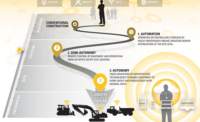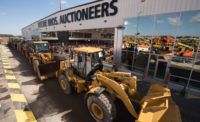With a modest milestone in the books, Komatsu America is about to ramp up its introduction of “intelligent” excavators and dozers to North American construction sites.
In 2013, the U.S. arm of the Japanese-based equipment manufacturer launched its intelligent machine-control (iMC) product line with the 168-horsepower D61PXi-23 dozer, dubbed “the world’s first intelligent dozer,” with fully automatic blade control.
“At that time, we explained that the technology was scalable,” says Peter Robson, senior director for Komatsu America’s iMC group. Since then, the D61PXi, now into its second generation, has been joined by five additional dozer model sizes, ranging from the 105-hp D39EXi-23 to the 354-hp D155AXi-8. Along the way, Komatsu America added an iMC excavator offering, the 21-metric-ton PC210LCi-10, with automated 3D GNSS capabilities (ENR 12/1/14 p. 21).
At a recent event at the company’s customer center in Cartersville, Ga., Robson and senior product manager Jason Anetsberger reported to ENR that more than 1,000 iMC machines are in the field in North America, some with more than 5,000 hours of service; in total, the company’s non-aftermarket machine-control technology has logged in-service hours “into the millions” across the U.S. and Canada.
These trends could be small potatoes compared to what’s coming. Although described by company officials as “a game-changer” in the excavator market, the 21-ton machine is positioned on the smaller side of the various makes and models at the core of North American earthmoving. As such, Komatsu America unveiled its first 36-metric-ton intelligent excavator, the PC360LCi-11, a few weeks after the introduction of the 49-metric-ton PC490LCi-11 loading tool, now out in very limited circulation. Size-wise, the PC360LCi-11 is a “bread-and-butter” machine for North American earthmoving contractors, which use it in applications ranging from ditching and trenching to mass excavating and heavy highway.
“We have high expectations for these bigger machines,” said Anetsberger. “That’s what the customers have been telling us they need and what we feel is a good answer to their pain point. They want the same capabilities that they have come to love on the dozers—the 3D capability and the automation—and that’s what we have delivered.”
Using the same design files as inputted into the dozers, the iMC excavators automatically limit overexcavation by halting the bucket’s downward movement once the target grade is reached. The machine controls automatically select the point on the bucket closest to the target surface, not just specific corners or edges of the bucket. Additionally, with the autograde-assist feature, the boom adjusts the bucket height automatically to trade the target surface. In many cases, this feature eliminates the need for a fine dozer to clean up the excavator’s work.
Komatsu also introduced a remote-controlled version of the D155AXi-8, the largest dozer model in the iMC product line. Unlike earlier remote-control dozers, this model leverages the machine-control features for accurate earthmoving in high-risk applications in which the operator is better positioned not to be in the cab due to environmental or physical conditions on the jobsite.
Various equipment manufacturers offer intelligent machines, but the definition of “intelligent” is not well defined. Some manufacturers add automated grade controls to smarten up models in the core product line, like Caterpillar’s 323F model, which competes with the Komatsu PC210LCi-10.
Regardless of other operating systems, Komatsu machines are integrating, said Robson. “It was very encouraging how quickly we got to this milestone and the adoption in the marketplace and seeing it transitioning to other machine-control environments around it,” he said. “That was a tough barrier in the beginning.”
Times are changing as original-equipment manufacturers adopt smart controls. “ ‘Machine control’ used to be a foreign word in every OEM’s portfolio,” explained Robson. “Basically, it was somebody else who did it. Not anymore.”




